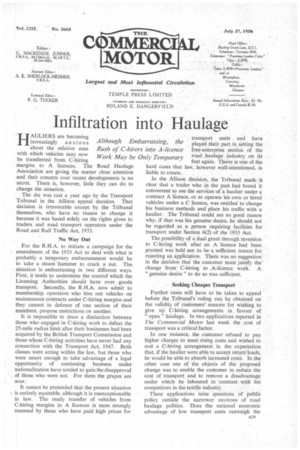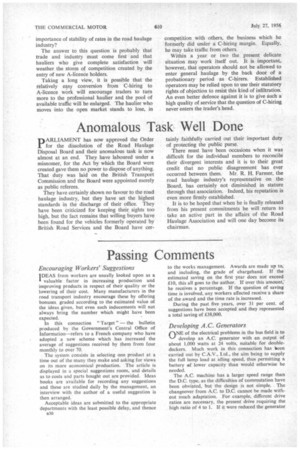Infiltration into Haulage
Page 35

Page 36

If you've noticed an error in this article please click here to report it so we can fix it.
• HAULIERS are becoming increasingly anxious about the relative ease with which vehicles may now be transferred from C-hiring margins to A licences. The Road Haulage Association are giving the matter close attention and their concern over recent developments is no secret. There is, however, little they can do to change the situation.
The die was cast a year ago by the Transport Tribunal in the Allison appeal decision. That decision is irrevocable except by the Tribunal themselves, who have no reason to change it because it was based solely on the rights given to traders and road transport operators under the Road and Rail Traffic Act, 1933.
No Way Out For the R.H.A. to initiate a campaign for the amendment of the 1933 Act to deal with what is probably a temporary embarrassment would be to take a steam hammer to crack a nut. The situation is embarrassing in two different ways. First, it tends to undermine the control which the Licensing Authorities should have over goods transport. Secondly, the R.H.A. now admit to membership operators who hire out vehicles on maintenance contracts under C-hiring margins and they cannot in defence of one section of their members, propose restrictions on another.
It is impossible to draw a distinction between those who engaged in C-hiring work to defeat the 25-mile radius limit after their businesses had been acquired by the British Transport Commission and those whose C-hiring activities have never had any connection with the Transport Act, 1947. Both classes were acting within the law, but those who were smart enough to take advantage of a legal opportunity of continuing business under nationalization have tended to gain the disapproval Cof those who were not. For them the grapes are sour.
It cannot be pretended that the present situation \ is entirely equitable, although it is unexceptionable in law. The ready transfer of vehicles from C-hiring margins to A licences is most strongly resented by those who have paid high prices for transport units and have played their part in setting the free-enterprise section of the road haulage industry on its feet again. Theirs is one of the hard cases that law, however well-intentioned, is liable to create..
In In the Allison decision, the Tribunal made it clear that a trader who in the past had found it convenient to use the services of a haulier under 0. contract A licence, or to operate his own or hired vehicles under a C licence, was entitled to change his business methods and place his traffic with a haulier. The Tribunal could see no good reason why, if that was his genuine desire, he should not be regarded as a person requiring facilities for transport under Section 6(2) of the 1933 Act.
The possibility of a dual grant through reversion to C-hiring work after an A licence had been granted was held not to be a sufficient reason for rejecting an application. There was no suggestion' in the decision that the customer must justify the change from C-hiring to A-licence work. A "genuine desire" to do so was sufficient.
Seeking Cheaper Transport Further cases will have to be taken to appeal before the Tribunal's ruling can be obtained on the validity of customers' reasons for wishing to give up C-hiring arrangements in favour of " open " haulage. In two applications reported in The Commercial Motor last week the cost of transport was a critical factor.
In one instance, the customer refused to pay higher charges to meet rising costs and wished to end a C-hiring arrangement in the expectation that, if the haulier were able to accept return loads, he would be able to absorb increased costs. In the other case one of the objects of the proposed change was to enable the customer to reduce the cost of transport and to remove a disadvantage under which he laboured in 'contrast with his competitors in the textile industry.
These applications raise questions of public policy outside the narrower environs of road haulage politics. Does the national economic advantage of low transport costs outweigh the importance of stability of rates in the road haulage industry?
The answer to this question is probably that trade and industry must come first and that hauliers who give complete satisfaction will weather the storm of competition created by the entry of new A-licence holders.
Taking a long view, it is possible that the relatively easy conversion from C-hiring to A-licence work will encourage traders to turn more to the professional haulier and the pool of available traffic will be enlarged. The haulier who moves into the open market stands to lose, in competition with others, the business which he formerly did under a C-hiring margin. Equally, he may take traffic from others.
Within a year or two the present delicate situation may work itself out. It is important, however, that operators should not be allowed to enter general haulage by the back door of a probationary period as C-hirers. Established operators may be relied upon to use their statutory rights of objection to resist this kind of infiltration. An even better defence against it is to give such a high quality of service that the question of C-hiring never enters the trader's head.












































































































